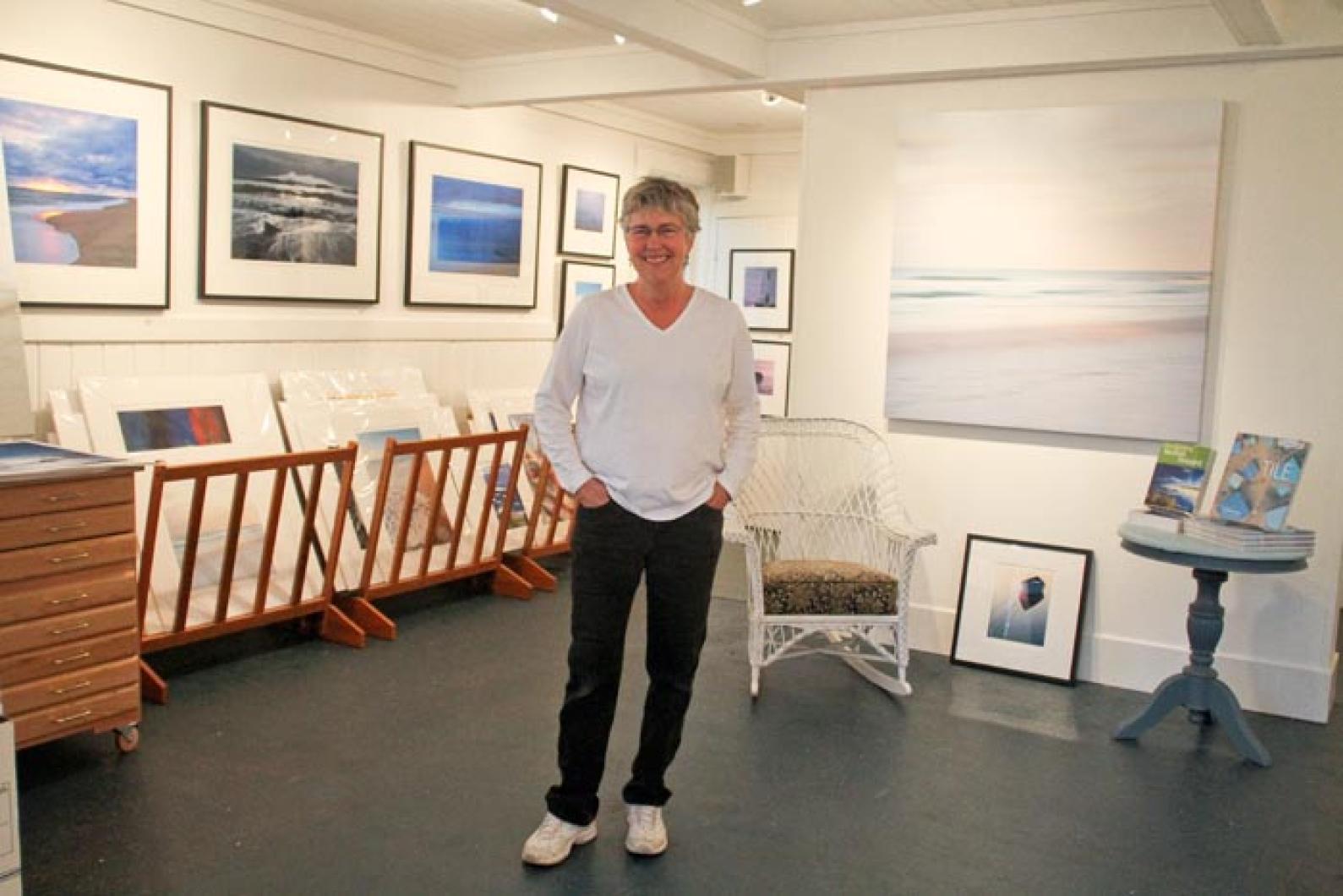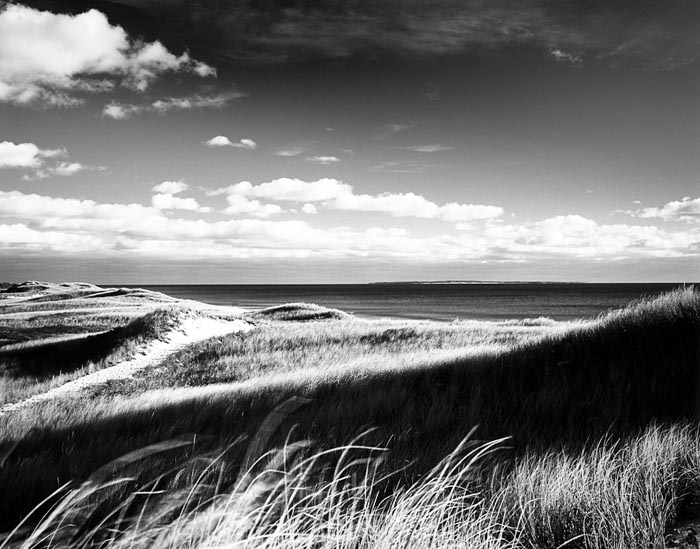If you visit the Alison Shaw Gallery during its opening this Memorial Day weekend, you may find yourself among the many who are inspired to go out and make photographs as calmly arresting and as quintessentially Vineyard as Ms. Shaw’s. If this is the case, the best remedy might be a copy of Ms. Shaw’s new book, Photographing Martha’s Vineyard: Where to Find Perfect Shots and How to Take Them.
The book is part of a series — other titles spotlight Cape Cod, the Maine coast and San Francisco — intended to offer a professional’s perspective on taking photos that go beyond the typical tourist shot.
And for Ms. Shaw, the entire process of creating a book was an exercise in going beyond. While she has collaborated with other Island artists and authors in the past, most recently providing the visuals for Tom Dunlop’s Schooner, Shelley Christiansen’s Martha’s Vineyard Tile and Tina Miller’s series of cookbooks, this is the first solo project in which she is both author and photographer.
“I like taking on new challenges,” she said in a recent interview. “I like doing things where there’s a level of discomfort or that I’m out of my element.” She continued:
“Not that I’m ever going to become a writer; I don’t want to. But it was the first time I really put on paper my feelings about the Island.”
It takes barely a paragraph for Ms. Shaw’s appreciation for the “quieter beauty” of the Vineyard to shine through in her book:
“Each time my feet are firmly planted back on the Island of Martha’s Vineyard, I realize this 100 square miles of sand, nestled off the south coast of Cape Cod, has as many photographic opportunities as any other place I’ve visited.”
Though the book is a slim 112-page volume, there are enough opportunities included within to keep the hobbyist and professional alike busy. Even those with no inclinations toward photography will find it useful for discovering new Island locales to explore. Most of us have visited the Edgartown Lighthouse and the Gay Head Cliffs, but how many have ventured to Pecoy Point Preserve in Oak Bluffs? Not even Ms. Shaw knew of the “lovely little spot” until she began work on the book and visited on the recommendation of James Lengyel, director of the Martha’s Vineyard Land Bank.
“I have my favorite places, and yet I know there’s so many more places that I haven’t yet explored,” Ms. Shaw said.
“I loved how [the research] pushed me to go back and double-check places and be sure about things and rewalk a preserve again,” she said. “And [I could] add to my life list of places that I like to photograph.”
Details such as the inclusion of Pecoy Point allow Photographing Martha’s Vineyard to rise above standard issue guidebook status. There is no question that the book is a guide — maps and directions are scattered throughout; information boxes appear at the start of each chapter, locations of public restrooms are included — yet Ms. Shaw was determined to place her personal mark on the final product and not conform precisely to a template. Her goal was to make the book read as if she were talking to a friend — while still making sure readers could go out and make good pictures.
“Even though there was a formula . . . to follow, I took what was here and made it my own,” she said. She drew on her years of teaching photography workshops to arrive at the right blend of technical jargon — much of which is concentrated in the first chapter for those who prefer to skim — and insider information.
“My concern [was] I wanted it to sound not like a machine, I wanted it to sound conversational,” she said.
Adding personal touches was at times far more challenging than expected for Ms. Shaw. Including some of her “little secret locations” in the book brought mixed feelings, even as she admits in the next breath that most aren’t secret at all. They’re just not as well-known or as readily accessible as others, like Lucy Vincent Beach, Ms. Shaw’s favorite place to photograph on the Vineyard [the directions for finding the beach are nearly as long as the paragraph describing the actual location]. Still, it can’t be easy to offer up a trade secret to the wider world.
Or offering up potentially outdated information.
“I’m freaking out about some places that I included in [the book] that maybe aren’t going to be as photogenic anymore — Wasque is one example,” said Ms. Shaw, referring to the toll erosion has taken on the once-scenic beach.
“That’s true of any guidebook, though,” she said. “They’ve just got to not print too many and be able to update that sort of thing. I thought I’d like to get it through at least one summer of being accurate.”
The writing process lasted a few short months, after which Ms. Shaw was ready to decide on the accompanying images. The oldest photo dates back to 1990, but creating a retrospective was the last thing on her mind as she searched her archives. She wanted each photo to be a true illustration, spotlighting a concept, location, or technique, and sought to create a balance between her best images and those that were new or unpublished.
Some 200 photos made the final cut, although she originally submitted 250 to the publishing company.
“They were really nice about letting me swap out [an image] if I needed to,” she said. “Everybody . . . the acquisitions person, the editor, the copy editor . . . has all been so easy to work with. I’ve gone through experiences with books before where I had no say. I turned it in, and that was it.”
Some of the photos were taken specifically for the book, although most were not. And if the prose of the book is intended to make a reader feel at home in the world of Vineyard photography, the photographs are surely there to draw the person in in the first place. Each seems more vibrant than the next, often as much about the quality of light in the image as the subjects themselves (a subtle lesson for readers to take away).
And of course the best part of the photos is that they’re made accessible by the very nature of the book. One thing is certain after reading Photographing Martha’s Vineyard: There’s always room for one — or two, or 20 — more photographers here.
“If anything, for me, the Island is getting bigger and bigger with the potential out there and the possibilities,” Ms. Shaw said.
Alison Shaw’s Photographing Martha’s Vineyard: Where to Find Perfect Shots and How to Take Them is available for purchase at the Alison Shaw Gallery and local bookstores. The gallery on Dukes County avenue opens to the public this weekend with a show of new work by Ms. Shaw. The opening reception is from 4 to 7 p.m. on Saturday.








Comments
Comment policy »